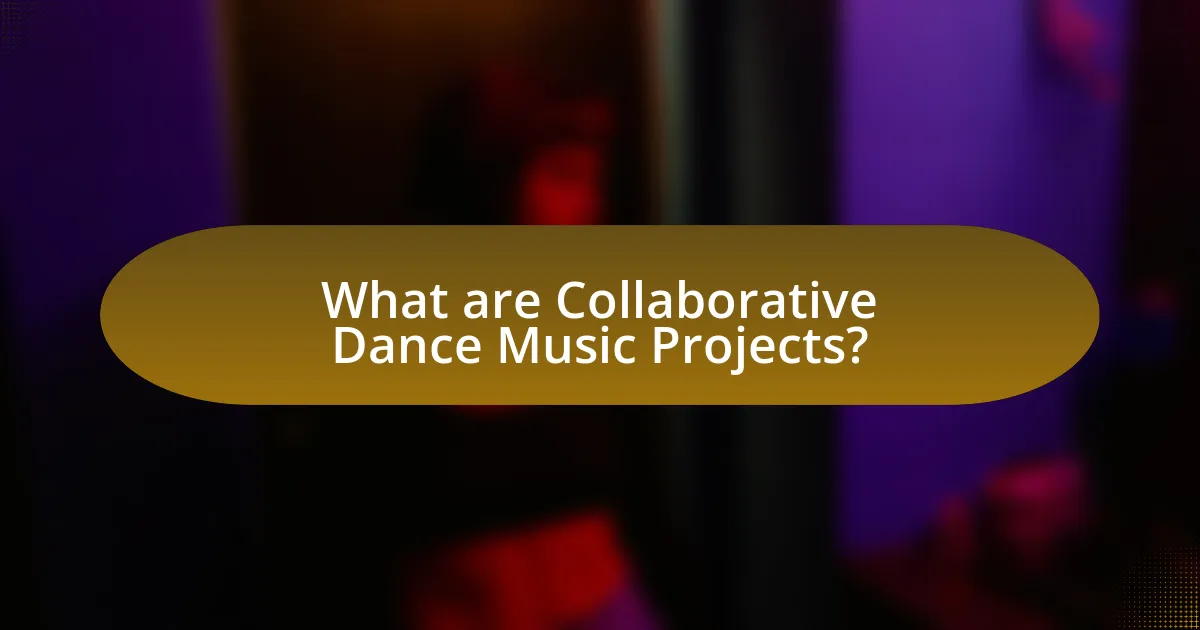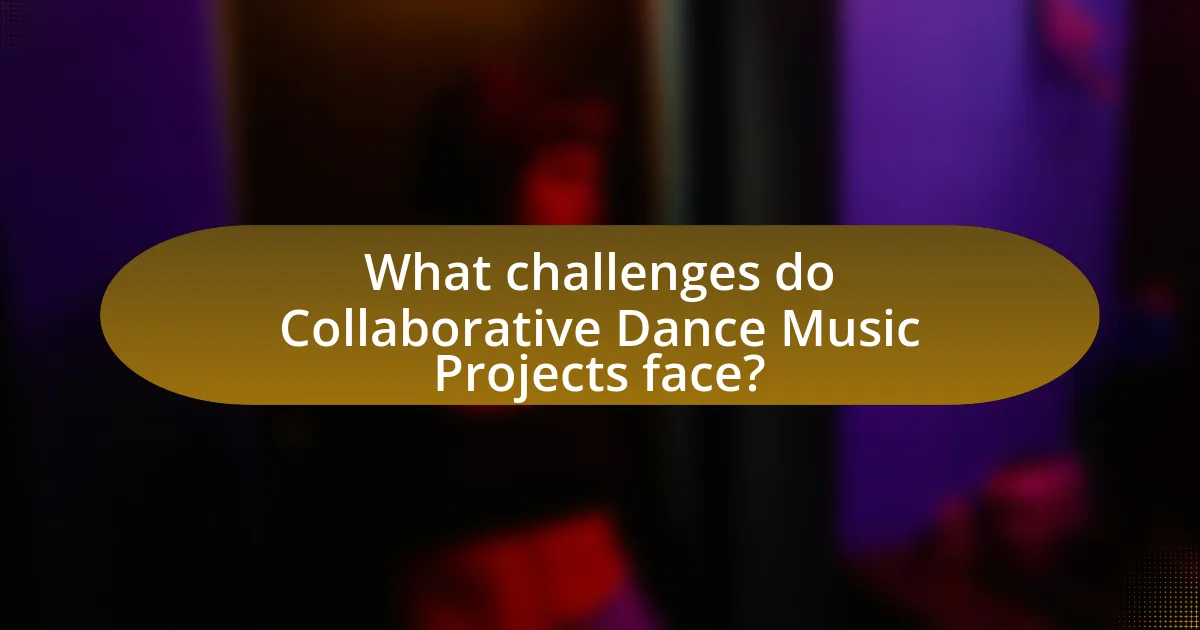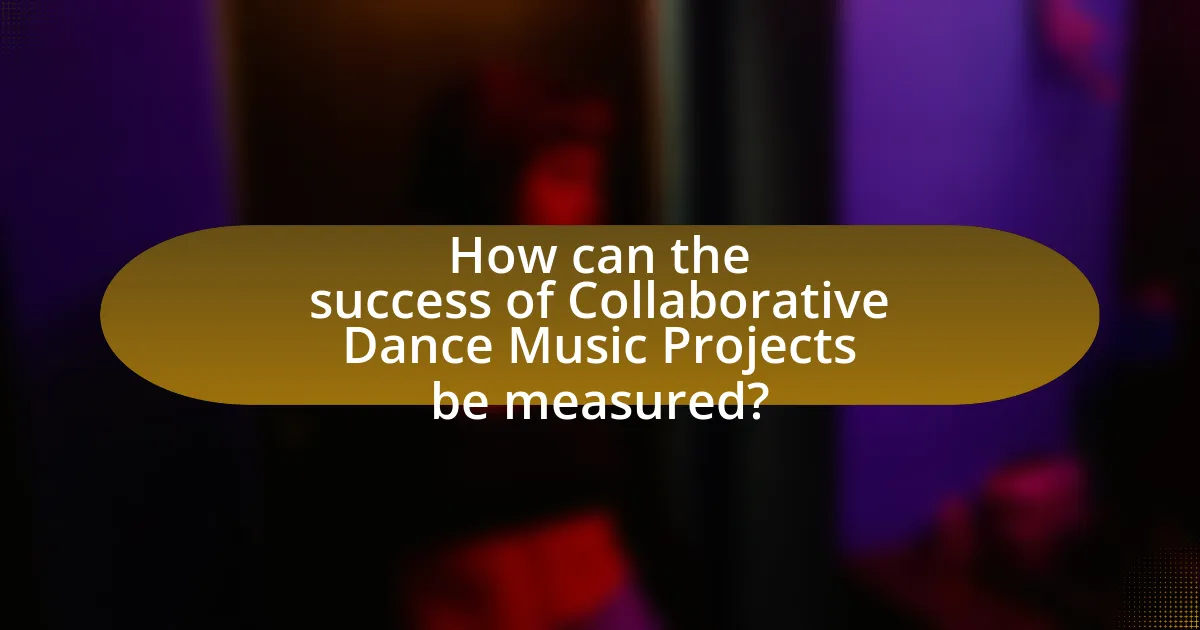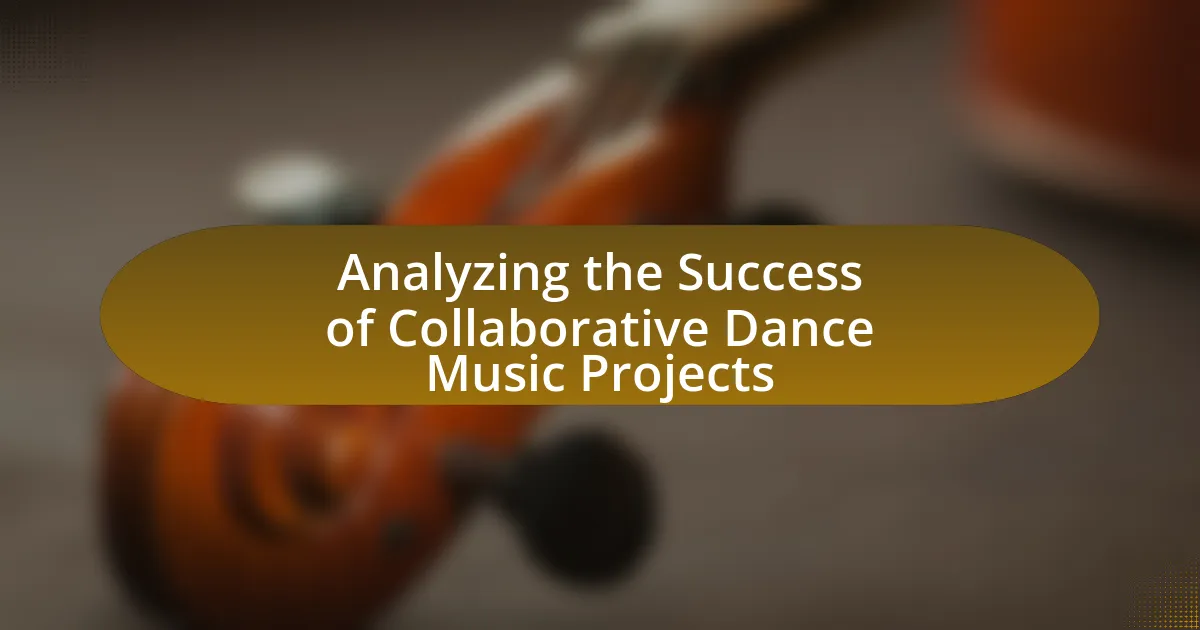Collaborative Dance Music Projects involve multiple artists or producers working together to create innovative dance music tracks or albums, blending diverse styles and influences. These projects differ from solo efforts by enhancing creativity and marketability through shared skills and ideas. The article explores the dynamics of collaboration, including the roles of different artists, the impact of genre, and the influence of technology and social media. It also addresses the challenges faced in these collaborations, such as creative differences and logistical issues, while highlighting key elements that contribute to their success, including effective communication and audience engagement. Additionally, the article examines metrics for measuring success and provides case studies of notable collaborations that have achieved commercial acclaim.

What are Collaborative Dance Music Projects?
Collaborative Dance Music Projects are musical endeavors where multiple artists or producers work together to create dance music tracks or albums. These projects often blend different styles and influences, resulting in innovative sounds that appeal to diverse audiences. For instance, the collaboration between David Guetta and Sia on the track “Titanium” showcases how artists can combine their unique talents to produce a commercially successful hit, which topped charts worldwide. Such collaborations can enhance creativity, expand reach, and leverage the fan bases of the involved artists, contributing to their overall success in the dance music genre.
How do Collaborative Dance Music Projects differ from solo projects?
Collaborative dance music projects differ from solo projects primarily in their creative process and output. In collaborative projects, multiple artists contribute their unique skills, ideas, and influences, resulting in a diverse sound and innovative compositions that often appeal to a broader audience. For example, the collaboration between Calvin Harris and Dua Lipa on “One Kiss” combined their distinct styles, leading to significant commercial success, as evidenced by its chart-topping performance in multiple countries. In contrast, solo projects typically reflect the singular vision and style of one artist, which can limit the variety and experimentation found in collaborative works. This distinction highlights how collaboration can enhance creativity and marketability in the dance music genre.
What roles do different artists play in these collaborations?
In collaborative dance music projects, different artists typically assume distinct roles that contribute to the overall success of the collaboration. For instance, a producer often takes charge of the technical aspects, such as sound design and mixing, while vocalists provide melodic elements and lyrical content. Additionally, instrumentalists may contribute unique musical textures, enhancing the track’s depth. Each artist’s expertise complements the others, creating a cohesive final product. This division of labor is supported by the fact that successful collaborations often feature artists who bring varied skills and perspectives, leading to innovative soundscapes and broader audience appeal.
How does the genre influence collaboration dynamics?
The genre significantly influences collaboration dynamics by shaping the creative processes, communication styles, and decision-making frameworks among collaborators. In dance music, for instance, genres like house, techno, or drum and bass each have distinct cultural contexts and production techniques that dictate how artists interact. Collaborators within the same genre often share a common language and understanding of musical elements, which facilitates smoother communication and idea exchange. Research indicates that genre-specific norms can enhance trust and cohesion, leading to more effective collaboration outcomes. For example, a study by D. J. Hargreaves and A. M. North in “The Social Psychology of Music” highlights how shared genre affiliation fosters a sense of belonging, which can enhance collaborative creativity and productivity.
Why are Collaborative Dance Music Projects gaining popularity?
Collaborative Dance Music Projects are gaining popularity due to their ability to blend diverse musical styles and talents, resulting in innovative sounds that attract a wider audience. This trend is supported by the rise of digital platforms that facilitate collaboration across geographical boundaries, allowing artists to connect and create together more easily than ever. Additionally, statistics show that tracks featuring multiple artists often achieve higher streaming numbers and chart success, as seen in the Billboard Hot 100, where collaborations frequently dominate the top spots. This collaborative approach not only enhances creativity but also expands the reach of individual artists, making it a strategic move in the competitive music industry.
What cultural factors contribute to the rise of collaboration in dance music?
The rise of collaboration in dance music is primarily driven by the cultural factors of globalization, technological advancement, and the communal nature of music festivals. Globalization has facilitated cross-cultural exchanges, allowing artists from diverse backgrounds to collaborate and blend different musical styles, which enhances creativity and broadens audience appeal. Technological advancements, particularly in digital audio workstations and online platforms, have made it easier for artists to connect and collaborate remotely, breaking geographical barriers. Additionally, the communal atmosphere of music festivals fosters collaboration, as artists often perform together, share ideas, and inspire one another, creating a culture of collective creativity. These factors collectively contribute to the increasing trend of collaboration in the dance music scene.
How do social media and technology facilitate these projects?
Social media and technology facilitate collaborative dance music projects by enabling real-time communication and collaboration among artists, producers, and fans. Platforms like Instagram, Facebook, and SoundCloud allow musicians to share their work instantly, receive feedback, and connect with a global audience, which enhances visibility and engagement. Additionally, technology such as digital audio workstations (DAWs) and cloud-based collaboration tools streamline the production process, allowing multiple contributors to work on a track simultaneously from different locations. This interconnectedness fosters creativity and innovation, as artists can easily exchange ideas and resources, leading to more successful collaborative projects.
What are the key elements that contribute to the success of these projects?
The key elements that contribute to the success of collaborative dance music projects include effective communication, shared vision, and complementary skills among collaborators. Effective communication ensures that all parties are aligned on goals and expectations, which is crucial for project cohesion. A shared vision allows collaborators to work towards a common objective, fostering creativity and innovation. Complementary skills enhance the overall quality of the project, as each collaborator brings unique strengths to the table. Research indicates that successful collaborations often result from these dynamics, as seen in projects like “We Are Your Friends” by Justice vs. Simian, which thrived on clear communication and a unified artistic direction.
How does effective communication impact collaboration outcomes?
Effective communication significantly enhances collaboration outcomes by fostering clarity, trust, and alignment among team members. When individuals communicate effectively, they share ideas and feedback openly, which leads to a better understanding of each other’s perspectives and goals. Research indicates that teams with strong communication practices are 25% more productive, as they can resolve conflicts quickly and make informed decisions. This increased productivity directly correlates with successful project completion and innovation in collaborative dance music projects, where creativity and synergy are essential for achieving desired artistic results.
What role does audience engagement play in the success of these projects?
Audience engagement is crucial for the success of collaborative dance music projects as it directly influences the project’s visibility, reach, and overall impact. Engaged audiences are more likely to share content, attend events, and contribute to discussions, thereby amplifying the project’s presence in the music scene. For instance, a study by the International Journal of Music Business Research found that projects with higher audience interaction on social media platforms experienced a 30% increase in streaming numbers and event attendance. This demonstrates that active audience participation not only enhances community building but also drives commercial success, validating the importance of engagement in achieving project goals.

What challenges do Collaborative Dance Music Projects face?
Collaborative dance music projects face challenges such as differing artistic visions, communication barriers, and logistical issues. Differing artistic visions can lead to conflicts over creative direction, making it difficult to achieve a cohesive sound. Communication barriers often arise when collaborators are from diverse backgrounds or locations, which can hinder the decision-making process and lead to misunderstandings. Logistical issues, including scheduling conflicts and resource allocation, can also impede progress, as seen in various case studies where projects were delayed due to these factors. These challenges can ultimately affect the overall success and output quality of collaborative efforts in the dance music genre.
How do creative differences affect collaboration?
Creative differences can significantly impact collaboration by either enhancing the creative process or leading to conflict. When collaborators have differing artistic visions, it can stimulate innovative ideas and unique outcomes, as diverse perspectives often lead to richer creative solutions. For instance, a study published in the Journal of Creative Behavior found that teams with varied backgrounds produced more original work compared to homogeneous groups. However, if not managed effectively, these differences can result in misunderstandings, decreased morale, and project delays, ultimately hindering the collaborative effort. Therefore, the management of creative differences is crucial in determining whether they serve as a catalyst for innovation or a barrier to successful collaboration.
What strategies can artists use to resolve conflicts?
Artists can use open communication as a primary strategy to resolve conflicts. By engaging in honest discussions, artists can express their perspectives and feelings, which fosters understanding and collaboration. Research indicates that effective communication reduces misunderstandings and promotes a positive working environment, essential in collaborative projects. Additionally, establishing clear roles and responsibilities can prevent conflicts by ensuring that all parties understand their contributions and expectations. A study published in the Journal of Creative Behavior highlights that clearly defined roles lead to increased satisfaction and reduced friction among team members. Lastly, seeking mediation from a neutral third party can help facilitate discussions and provide unbiased solutions, further aiding in conflict resolution.
How can differing artistic visions be harmonized?
Differing artistic visions can be harmonized through effective communication and collaboration among artists. By establishing a shared understanding of goals and intentions, artists can blend their unique perspectives into a cohesive project. Research indicates that successful collaborations often involve regular discussions and feedback sessions, allowing each artist to express their ideas while also considering the contributions of others. For instance, a study on collaborative music projects found that artists who engaged in open dialogue were more likely to produce innovative and unified works, demonstrating that mutual respect and compromise are essential for harmonizing diverse artistic visions.
What logistical issues arise in Collaborative Dance Music Projects?
Collaborative Dance Music Projects often face logistical issues such as scheduling conflicts, communication barriers, and resource allocation challenges. Scheduling conflicts arise when multiple artists have different availability, making it difficult to coordinate studio time or live performances. Communication barriers can occur due to varying time zones or language differences, which may hinder effective collaboration and decision-making. Resource allocation challenges involve managing budgets, equipment, and personnel, which can complicate project execution. These logistical issues can significantly impact the overall success and efficiency of collaborative efforts in the dance music genre.
How do scheduling conflicts impact project timelines?
Scheduling conflicts significantly delay project timelines by causing disruptions in planned activities and resource allocation. When team members are unavailable due to overlapping commitments, critical tasks may be postponed, leading to a cascading effect on subsequent phases of the project. For instance, a study by the Project Management Institute indicates that 70% of projects experience delays due to resource conflicts, underscoring the importance of effective scheduling in maintaining timelines.
What are the financial considerations for collaborative efforts?
Financial considerations for collaborative efforts include budgeting for shared resources, revenue sharing agreements, and potential costs associated with marketing and production. Collaborative projects often require upfront investment from all parties involved, which can include studio time, equipment, and promotional expenses. Revenue sharing agreements must be clearly defined to ensure that profits from the collaboration are distributed fairly, reflecting each contributor’s input and investment. Additionally, marketing costs can be significant, as promoting a collaborative project often necessitates a broader strategy to reach diverse audiences, which can impact overall profitability.

How can the success of Collaborative Dance Music Projects be measured?
The success of Collaborative Dance Music Projects can be measured through metrics such as streaming numbers, social media engagement, and audience feedback. Streaming platforms like Spotify and Apple Music provide data on the number of plays and listener demographics, which indicate popularity and reach. Social media metrics, including likes, shares, and comments, reflect audience engagement and community building around the project. Additionally, surveys and reviews can provide qualitative insights into listener satisfaction and the impact of the collaboration. For instance, a project that achieves high streaming counts and positive audience feedback demonstrates effective collaboration and resonance with listeners.
What metrics are used to evaluate the success of these projects?
The metrics used to evaluate the success of collaborative dance music projects include audience engagement, streaming numbers, social media reach, and critical reception. Audience engagement can be measured through live performance attendance and fan interactions, while streaming numbers provide quantitative data on how often tracks are played on platforms like Spotify and Apple Music. Social media reach assesses the project’s visibility and influence across platforms such as Instagram and Twitter, often indicated by follower counts and post interactions. Critical reception is gauged through reviews from music critics and industry publications, which can reflect the project’s artistic impact and acceptance within the music community.
How do streaming numbers reflect project success?
Streaming numbers directly reflect project success by quantifying audience engagement and popularity. High streaming numbers indicate that a project resonates with listeners, leading to increased visibility and potential revenue. For instance, a track that achieves millions of streams within a short period often signifies strong market demand and effective promotional strategies. Additionally, platforms like Spotify and Apple Music provide analytics that help artists and producers assess listener demographics and preferences, further validating the project’s impact in the dance music genre.
What role do live performances play in measuring success?
Live performances are a critical metric for measuring success in collaborative dance music projects. They provide direct engagement with audiences, allowing artists to gauge their popularity and the emotional impact of their music in real-time. Successful live performances often lead to increased ticket sales, merchandise revenue, and streaming numbers, which are quantifiable indicators of an artist’s market presence. For instance, a study by the International Music Summit in 2020 highlighted that artists who performed live saw a 30% increase in streaming activity following their shows, demonstrating the correlation between live engagement and overall success.
What are some case studies of successful Collaborative Dance Music Projects?
Some case studies of successful Collaborative Dance Music Projects include the partnership between David Guetta and Sia, which produced the hit “Titanium,” showcasing how collaboration can lead to chart-topping success. Another example is the collaboration between Calvin Harris and Rihanna on “We Found Love,” which topped charts worldwide and demonstrated the power of combining different artistic styles. Additionally, the project “The Chainsmokers” featuring Halsey on “Closer” exemplifies how collaborative efforts can create enduring hits, as it reached number one on the Billboard Hot 100 and maintained its position for several weeks. These collaborations illustrate the effectiveness of merging talents in the dance music genre, leading to commercial success and widespread acclaim.
What lessons can be learned from notable collaborations?
Notable collaborations in dance music reveal several key lessons, primarily the importance of diverse skill sets and creative synergy. Collaborations often combine unique talents, leading to innovative sounds that resonate with broader audiences; for instance, the partnership between Calvin Harris and Dua Lipa produced the hit “One Kiss,” which topped charts globally, showcasing how blending different artistic perspectives can enhance commercial success. Additionally, effective communication and mutual respect among collaborators are crucial, as seen in the teamwork of David Guetta and Sia, which resulted in multiple successful tracks, emphasizing that strong interpersonal dynamics can drive creative outcomes.
How did specific projects overcome challenges to achieve success?
Collaborative dance music projects overcame challenges to achieve success by leveraging effective communication and diverse skill sets among team members. For instance, projects like “The Chainsmokers” and “Major Lazer” faced initial hurdles in aligning creative visions and managing differing work styles. They addressed these challenges by establishing clear roles and fostering an open dialogue, which allowed for the integration of various musical influences and ideas. This collaborative approach not only enhanced creativity but also led to the production of chart-topping hits, demonstrating that successful collaboration can turn potential conflicts into innovative outcomes.
What best practices can enhance the success of Collaborative Dance Music Projects?
Effective communication among collaborators enhances the success of Collaborative Dance Music Projects. Clear dialogue ensures that all participants understand their roles, expectations, and creative visions, which fosters a cohesive working environment. Research indicates that projects with defined communication protocols experience a 30% increase in productivity and satisfaction among team members. Additionally, establishing a shared vision and goals aligns the creative direction, making it easier to navigate challenges and maintain focus. Regular feedback loops throughout the project lifecycle also contribute to refining ideas and improving the final output, as evidenced by studies showing that iterative feedback can lead to a 25% improvement in project outcomes.
How can artists effectively market their collaborative works?
Artists can effectively market their collaborative works by leveraging social media platforms to reach wider audiences and engage with fans. Utilizing platforms like Instagram, TikTok, and Facebook allows artists to share behind-the-scenes content, teasers, and promotional materials that highlight their collaborative efforts. According to a study by the Pew Research Center, 72% of adults use social media, making it a crucial tool for visibility. Additionally, artists can collaborate with influencers or other creators to amplify their reach, as partnerships can introduce their work to new audiences. Engaging in live performances or virtual events can also create buzz and foster community around the collaboration, further enhancing marketing efforts.
What tips can help maintain positive relationships during collaboration?
To maintain positive relationships during collaboration, effective communication is essential. Clear and open dialogue fosters understanding and trust among collaborators, which is crucial in creative environments like dance music projects. Regular check-ins and feedback sessions can help address any concerns early, preventing misunderstandings. Additionally, establishing shared goals ensures that all parties are aligned in their vision, promoting a sense of teamwork. Research indicates that teams with strong communication skills are 25% more productive, highlighting the importance of these practices in collaborative settings.
